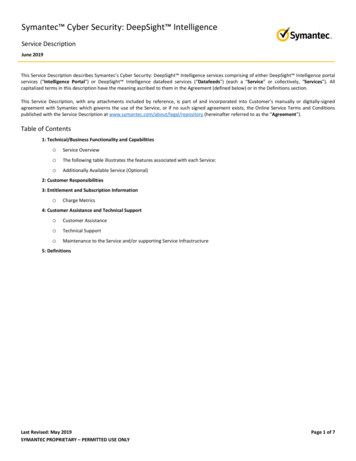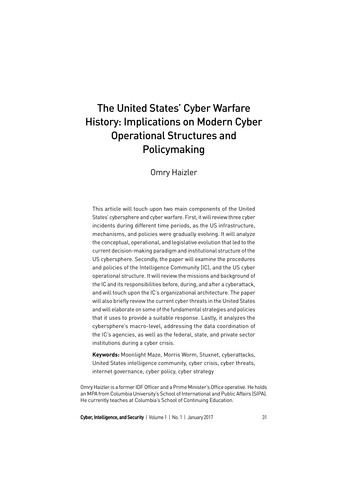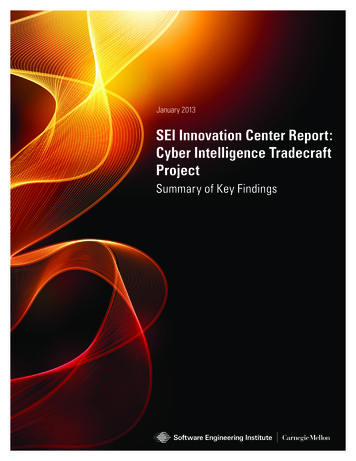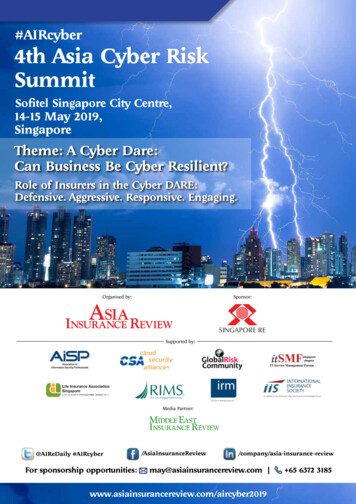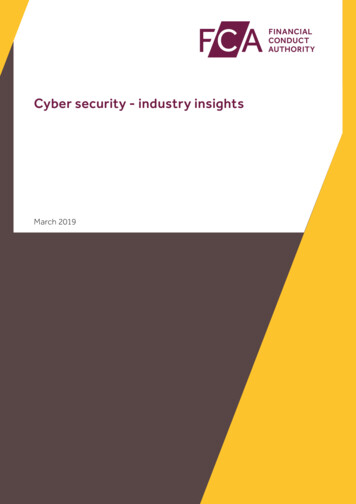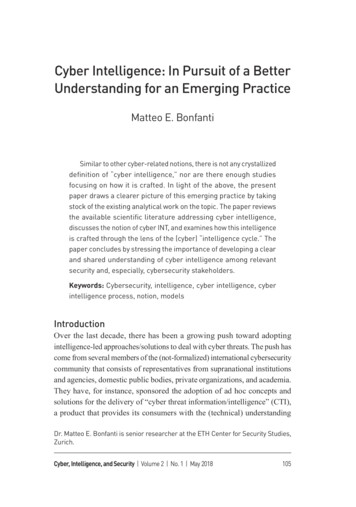
Transcription
Cyber Intelligence: In Pursuit of a BetterUnderstanding for an Emerging PracticeMatteo E. BonfantiSimilar to other cyber-related notions, there is not any crystallizeddefinition of “cyber intelligence,” nor are there enough studiesfocusing on how it is crafted. In light of the above, the presentpaper draws a clearer picture of this emerging practice by takingstock of the existing analytical work on the topic. The paper reviewsthe available scientific literature addressing cyber intelligence,discusses the notion of cyber INT, and examines how this intelligenceis crafted through the lens of the (cyber) “intelligence cycle.” Thepaper concludes by stressing the importance of developing a clearand shared understanding of cyber intelligence among relevantsecurity and, especially, cybersecurity stakeholders.Keywords: Cybersecurity, intelligence, cyber intelligence, cyberintelligence process, notion, modelsIntroductionOver the last decade, there has been a growing push toward adoptingintelligence-led approaches/solutions to deal with cyber threats. The push hascome from several members of the (not-formalized) international cybersecuritycommunity that consists of representatives from supranational institutionsand agencies, domestic public bodies, private organizations, and academia.They have, for instance, sponsored the adoption of ad hoc concepts andsolutions for the delivery of “cyber threat information/intelligence” (CTI),a product that provides its consumers with the (technical) understandingDr. Matteo E. Bonfanti is senior researcher at the ETH Center for Security Studies,Zurich.Cyber, Intelligence, and Security Volume 2 No. 1 May 2018105
Matteo E. Bonfanti Cyber Intelligence: In Pursuit of a Better UnderstandingCyber, Intelligence, and Security Volume 2 No. 1 May 2018106of malicious networks operations and activities and enables them to takesubsequent actions.1 However, CTI alone does not prove to be fully suitablefor supporting advanced prevention of cyberthreats.2 This is due to thetechnical nature and strictly operational scope of cyber threat information/intelligence that allows its consumers to understand network events andtrends (“inside the wire perspective”) and adopt reactive measures. Generally,CTI products are not built and do not provide knowledge on the wider andarticulated context within which cyber threats are framed.3 They do not grantthe understanding of cyber threat ecosystems nor do they enable advancedprediction/prevention.By endorsing the idea that organizations should move from reactive toproactive security management postures and opposing the attitude to interpretcybersecurity mostly as “measures taken after-the-event” and “static perimeterdefense,” different representatives of the cybersecurity community are nowsponsoring the adoption of concepts, tools, and practices for the crafting andsharing of all-encompassing intelligence about cyber threats.4 This intelligenceshould enable its consumers to comprehend the operational, tactical, andstrategic contexts of the threats (agents, capabilities, motivations, goals,impact, and consequences not only from a technical perspective), foreseetheir developments in the short, mid, and long terms, and take informeddecisions on preventive actions to be taken. If integrated in their securityrelated decision-making processes, it should enable organizations to assume1234Sharing of threat information, current attack patterns, software vulnerabilities and soforth have been standardized in process through the establishment of a network ofCSIRTs (Computer Security Incident Response Teams). They have been augmentedby the establishment and development of a number of initiatives, such as STIX/TAXII, CyBox, MISPs (Malware Information Sharing Platform). See, for rian P. Kime, “Threat Intelligence: Planning and Direction,” SANS Institute InfoSecReading Room (2017), p. 3, ion-36857. As stressed by theauthor, Indicators of Compromise (IOCs), like virus signatures and IP addresses,hashes of malware files or URLs or domain names of botnet command and controlservers are not by themselves intelligence. They are information useful for networkstatic defense.See Michael Montecillo, “Why Context is King,” Security Intelligence, April 22,2014, urity-context-king/.The term “proactive” should be here understood as the capacity to address actualpotential cyber threats by strengthening defense and response measures.
Matteo E. Bonfanti Cyber Intelligence: In Pursuit of a Better Understanding567See also below.Matteo E. Bonfanti, “Another –INT on the Horizon? Cyber intelligence is the NewBlack,” paper presented at the Intelligence in the Knowledge Society Conference,Bucharest, October 26–27, 2017. An anthology of presented papers will be publishedin 2018.At least this seems to be the case in some of the literature reviewed for the purposeof writing this paper. See, for example, Mario Caligiuri, Cyber Intelligence. Tralibertà e sicurezza (Roma: Donzelli, 2016); Mario Caliguiri, “Cyber Intelligence, laSfida dei Data Scientist,” June 2016, rofondimenti/cyber cyber intelligence-la-sfida-dei-data-scientist.html; AntonioTeti, “Cyber Intelligence e Cyber Espionage. Come Cambiano i Servizi di Intelligencenell’Era del Cyber Spazio,” Gnosis. Rivista Italiana d’Intelligence 3 (2013): 95–121;Umberto Gori and Luigi S. Germani, Information Warfare 2011. La sfida della CyberIntelligence al sistema Italia (Bologna: Franco Angeli 2012).107Cyber, Intelligence, and Security Volume 2 No. 1 May 2018“predictive and anticipatory rather than past-oriented,” “dynamic than static,”and “agile and quick adaptable than rigid and conformed” postures towardcyber-related perils. The above-described intelligence is often labeled “cyberintelligence” (cyber INT or CYBINT) to differentiate it from the technicallyinterpreted and narrow scope “cyber threat information/intelligence.” Ingeneral, cyber intelligence is used to convey the idea of widely scoped andbetter qualified knowledge of actual or potential events regarding cyberspacethat may endanger an organization.5Similar to many other cyber-related notions, there is neither a crystallizeddefinition nor a real common understanding of cyber intelligence—as a productand/or process—among policy makers, practitioner organizations, scholars,and public opinion. If one looks at the relevant policies or mechanisms thathave been recently implemented (especially across Europe) as well as otherdocumentation issued by private or public organizations and the academia,cyber intelligence is not always comprehensively defined and definitionsvary.6 Despite the growing use of this or similar expressions by the media aswell as scholars and practitioners (especially by cybersecurity vendors formarketing reasons), current thinking on the subject is limited and not welldeveloped. This holds especially true if one looks at the academic or otherintellectual works on the topic that have been so far produced in Europe.7A deeper investigation of the subject—both from a theoretical and practicalstandpoint—is missing. On the contrary, the academic and practitioners’reflections on cyber intelligence are relatively more advanced among the
Matteo E. Bonfanti Cyber Intelligence: In Pursuit of a Better UnderstandingCyber, Intelligence, and Security Volume 2 No. 1 May 2018108US security and cybersecurity stakeholders.8 This could be the consequenceof the earlier adoption of cyber intelligence-related concepts, practices, andtechnological solutions by US-based organizations.9 However, given that thepush toward the adoption of cyber intelligence programs seems to be on therise also among non-US cybersecurity stakeholders, it is worth expanding thediscussion on this topic. In particular, it may be valuable to examine the notionof cyber intelligence in more detail as well as understand the implicationsarising from the employment of cyber INT-led approaches, methodologies,tools, and cooperation frameworks by national agencies and organizations.The present paper intends to provide a targeted contribution to the debateon cyber intelligence. It tries to draw a clearer picture of this emergingpractice by taking stock of the existing analytical works on the topic. Thepaper reviews the available scientific literature addressing cyber intelligence,discusses the notion of cyber intelligence, and examines how it is craftedthrough the lens of the (cyber) “intelligence cycle.” The paper concludes bystressing the need for a clear and shared understanding of cyber intelligenceamong relevant security and, especially, cybersecurity stakeholders.108In addition to the literature that is cited below, see also discussion held by UScybersecurity stakeholders on the Cyber Intelligence Blog at https://cyberintelblog.wordpress.com/.9 See, for example, Office of the Director of National Intelligence, “The NationalIntelligence Strategy of the United States of America,” 2014, https://www.dni.gov/files/documents/2014 NIS Publication.pdf. The strategy defines cyber intelligence asfollows: “the collection, processing, analysis, and dissemination of information fromall sources of intelligence on foreign actors’ cyber programs, intentions, capabilities,research and development, tactics, and operational activities and indicators; theirimpact or potential effects on national security, information systems, infrastructure,and data; and network characterization, or insight into the components, structures,use, and vulnerabilities of foreign information systems.” Ibid., p. 8. See also USDepartment of Defense Science Board, “Resilient military systems and the advancedcyber threat,” January 2013, pp. 46 and 49, http://www.dtic.mil/docs/citations/ADA569975; US Department of Defense Science Board, “The Department ofDefense Cyber Strategy,” April, 2015, p. 24, 15 cyberstrategy/Final 2015 DoD CYBER STRATEGY for web.pdf.10 The paper is based on preliminary research that is currently carried out as part of athree-year research project defined and run by the author.
Matteo E. Bonfanti Cyber Intelligence: In Pursuit of a Better UnderstandingIn everyday language, “cyber intelligence” is mainly used as an envelopingand catch-all expression. What is cyber intelligence more exactly? As a productand a process, is it intelligence “from,” “on,” “within” or “for” cyberspaceor some combination thereof? To what extent does it focus on this space orcover events/phenomena occurring in the physical domain? What are themain sources of cyber INT? How is it crafted? Is the “traditional” intelligencecycle applicable to cyber intelligence? What are the issues associated withthe crafting and sharing of cyber intelligence? Answering to these frameworkor other more specific questions is not trivial.For instance, the lack of a uniform understanding of the term “cyber”hinders any attempt to come up with a comprehensive and uniform notion ofcyber intelligence. Indeed, whereas it is more or less undisputed establishingwhat intelligence (as product and process) is, defining it in relation to thecyber domain is challenging. In general, reflections on cyber intelligenceemploy concepts, frameworks, and terminology derived from the intelligencecommunity and adopt/adapt them to cyberspace.11 This seems to be a logicalapproach given that some concepts are already established and there is noneed to “re-invent the wheel.” One may wonder, however, to what extent theseconcepts are applicable to a domain that differs from the traditionally knowndomains. Cyber is, in fact, a man-made, highly evolving, technologicallyshaped, and not fully tangible environment, which, perhaps, needs to beinterpreted through different paradigms. Its interactions with the physical/real domain are yet to be fully understood.Furthermore, cyber intelligence is a relatively new practice, which isfar from being fully tested, assessed, and developed. There is not enoughshared experience on how it works and on the best capabilities to carryit out effectively. This hampers any attempt to come up with a thoroughinterpretative model for cyber INT.The above considerations are important. They should not be disregardedby anyone who tried to adopt a less biased or uncertain approach to the study11 Robert M. Lee, “An Introduction to Cyber Intelligence,” (blog) Tripwire, January16, 2014, y-data-protection/introduction-cyber cyber intelligence/; Stephanie Helm, “Intelligence, Cyberspaceand National Security,” paper given at EMC Chair Symposium.109Cyber, Intelligence, and Security Volume 2 No. 1 May 2018On Terminology and (Shared) Notions
Matteo E. Bonfanti Cyber Intelligence: In Pursuit of a Better UnderstandingCyber, Intelligence, and Security Volume 2 No. 1 May 2018110of cyber intelligence. They help in explaining why there is not yet an agreedand crystallized definition of cyber intelligence.Cyber Intelligence: Actionable Knowledge “From” or“For” Cyber?Depending on the scope of the information-gathering activities, the meansemployed to carry them out and the final purpose they serve, there areactually two ways of looking at or interpreting cyber intelligence.12 One wayis to think about cyber INT as intelligence “from” cyber; that is, knowledgeproduced through the analysis of any valuable information collected “within”or “through” cyberspace. This is the cyber intelligence stricto sensu. Fromthis perspective, “cyber” refers to both the domain where data are sourcedor—in other words— that vast digital repository of information amenable tobe retrieved and processed; and the tools/techniques/media through whichthese data are collected (for example, via Computer Network Exploitationtechnologies and techniques).13 According to this interpretation, cyber INT can,in principle, support decision making in any domain and not only to countercyber threats. It can support a broad variety of missions in government, industry,and academia, including policy making, strategic planning, internationalnegotiations, risk management, and strategic communication in areas beyondcybersecurity.14 In other words, cyber intelligence may operate “independentlyand does not necessarily need to support a cybersecurity mission.”15 However,given that cyber intelligence is often discussed in relation to cybersecurity orthe prevention of and response to cyber threats, these are the primary—but,again, not exclusive—goals of this type of intelligence.12 Matthew M. Hurley, “For and From Cyberspace Conceptualizing Cyber Intelligence,Surveillance, and Reconnaissance,” Air & Space Power Journal 26, no. 6 (2012):12–33.13 Ross W. Bellaby, “Justifying Cyber-Intelligence?” Journal of Military Ethics 15, no.4 (2016): 299–319; Hurley, “For and From Cyberspace,” p. 13. Computer NetworkExploitation or cyber exploitation refers to the secret collection and reproduction ofdigital data from computers or networks.14 Troy Townsend, Melissa K. Ludwick, Jay McAllister, Andrew O. Mellinger, and KateA. Sereno, “SEI Innovation Center Report: Cyber Intelligence Tradecraft Project:Summary of Key Findings,” (January 2013), pp. 2.01–2.20, spec. 2.5, https://resources.sei.cmu.edu/asset files/WhitePaper/2013 019 001 40212.pdf.15 Ibid.
Matteo E. Bonfanti Cyber Intelligence: In Pursuit of a Better Understanding16 Aaron F. Brantly, The Decision to Attack: Military and Intelligence Cyber DecisionMaking (Athens GA: University of Georgia Press, 2016), Ch. 7, pp. 103–108 and116–121.17 Intelligence and National Security Alliance, “Operational Levels of Cyber Intelligence,”September 2013, pp. 1–14, ybercyber intelligence/. See also Intelligence and National Security Alliance, “CyberIntelligence: Setting the Landscape for an Emerging Discipline,” September 2011,pp. 1–20, https://www.insaonline.org/cyber cyber discipline/. On the existing intelligence disciplines, see, amongothers, the UK Ministry of Defence, “Understanding and Intelligence Support toJoint Operations,” Joint Doctrine Publication 2-00, August 2011, ds/attachment data/file/311572/20110830jdp2 00 ed3 with change1.pdf.111Cyber, Intelligence, and Security Volume 2 No. 1 May 2018Another way to interpret cyber INT is considering it as intelligence “for”cyber; that is, insight that is derived from an all-source intelligence activityoccurring within and outside cyberspace. It is cyber intelligence lato sensu.In this sense, the intelligence “for” cyber can also include (or be built on)intelligence “from” cyber. It can draw from any intelligence discipline thatsupplies crucial knowledge, regardless of the source, method, or mediumemployed for crafting it. As such, cyber intelligence may therefore result fromthe combination of Open Source Intelligence (OSINT), Signal Intelligence(SIGINT), Geospatial Intelligence (GEOINT), Social Media Intelligence(SOCMINT), and Human Intelligence (HUMINT).16 From this point ofview, cyber intelligence is less a discipline itself than an analytic practicerelying on information/intelligence collected also through other disciplinesand intended to inform decision makers on issues pertaining to activities inthe cyber domain.17 What qualifies this kind of intelligence as “cyber ” is thepurpose for which it is crafted: to support decision making on cyberspacerelated issues.The two discussed perspectives on cyber intelligence—intelligence “from”and “for” cyber—are often condensed into one single comprehensive concept.This is also due to the fact that intelligence “for” cyber actually incorporatesthe one “from” cyber. The result is a broader notion of cyber intelligencethat includes the collection, processing, evaluation, analysis, integration, andinterpretation of information that is available “within,” “through,” and/or“outside” cyberspace to enhance decision making on cyber-related menaces.It is worth noting, however, that when looking at the “traditional”intelligence disciplines encompassed by the notion of cyber intelligence
Matteo E. Bonfanti Cyber Intelligence: In Pursuit of a Better UnderstandingCyber, Intelligence, and Security Volume 2 No. 1 May 2018112lato sensu, their narrower and circumscribed projection on cyberspace hasdetermined the development of ad hoc concepts and approaches often referredas virtual HUMINT, virtual or internet-based OSINT, virtual COMINT,and so forth. The adjective “virtual” indicates that intelligence activitiesare carried out within the cyberspace or through computer-generated tools.The association of “virtual” with “traditional” INT concepts/practices refersto the adoption of methods/approaches/tools that are employed by theselatter practices and adapted for cyberspace.18 A bit different from the aboveconcepts is the notion of SOCMINT. According to some scholars/practitioners,SOCMINT is as a stand-alone discipline that has specific features.19As for the information for crafting cyber intelligence, this may rangefrom network technical data (for example, hardware and software data), dataon hostile organizations and their capabilities, ongoing cyber activities, topotentially any relevant data on geopolitical events.20 The type of data as wellas its classification are not functional to the definition of cyber intelligence.Data can be raw or already processed information; it can be obtained legallyor through unlawful intrusion/exploitation actions from open, proprietary,or other classified sources.21 As the literature suggests, multiple sourcesof information are needed to develop a more holistic understanding of thethreat environment and to produce a comprehensive cyber INT.22 The mostimportant aspect of the data is that it should be somehow validated. Whenanalyzed, information should allow decision makers to identify, track, andpredict cyber capabilities, intentions, and activities that offer courses of18 For example, the virtual HUMINT approach aims at collecting tactical/operationalintelligence from the information generated by members of virtual communities.19 David Omand, Jamie Bartlett, and Carl Miller, #Intelligence (London: Demos Publishing,2012). See also, Matteo E. Bonfanti, “Social Media Intelligence a Salvaguardiadell’Interesse Nazionale. Limiti e Opportunità di una Pratica da Sviluppare,” inIntelligence e Interesse Nazionale, ed. Umberto Gori and Luigi Martino (Rome:Aracne, 2015), pp. 231–262.20 Jung-ho Eom, “Roles and Responsibilities of Cyber Intelligence for Cyber Operationsin Cyberspace,” International Journal of Software Engineering and Its Applications8, no. 9 (2014): 137–146. This article deals with cyber intelligence for militarypurposes.21 Robert M. Lee, “Cyber Intelligence Collection Operations,” 2014, y-data-protection/cyber cyber intelligencecollection-operations/.22 Intelligence and National Security Alliance, “Cyber Intelligence,” p. 1.
Matteo E. Bonfanti Cyber Intelligence: In Pursuit of a Better Understanding23 Townsend et al., “SEI Innovation Center Report.”24 See for example, Randy Borum, “Getting ‘Left of the Hack’: Honing Your CyberIntelligence Can Thwart Intruders,” InfoSecurity Professional (September/October2014), https://works.bepress.com/randy borum/63/.25 Randy Borum, John Felker, Sean Kern, Kristen Dennesen, and Tonya Feyes, “StrategicCyber Intelligence,” Information & Computer Security 23, no. 3 (2015): 317–332.See also, Intelligence and National Security Alliance, “Strategic Cyber Intelligence,”March, 2014, pp. 1–16, https://www.insaonline.org/strategic-cyber cyber intelligence/.26 Intelligence and National Security Alliance, “Tactical Cyber Intelligence,” December,2015, pp. 1–16, https://www.insaonline.org/tactical-cyber cyber intelligence/.27 Ibid.113Cyber, Intelligence, and Security Volume 2 No. 1 May 2018action.23 This is the main feature of cyber intelligence; that is, the enablinggoal of providing its consumers with insight into potentially hostile activitiesthat may occur in the cyber domain or may be perpetrated through or againstcyberspace, allowing them to design effective preventive (proactive) orcounteractive (reactive) measures.Depending on its scope or level of actionability, cyber intelligence canbe strategic, tactical, or operational.24 There is no uniform interpretationof what the different levels of cyber INT should consist. According to theavailable literature, strategic cyber INT focuses on the long term. Typically,it reviews trends in current and emerging threats and examines opportunitiesto contain these threats. It serves apical decision-making processes aimedat achieving an organization’s mission and determining its direction andobjectives. Strategic cyber INT covers the threat landscape for macro trends(political, social, and economic) affecting the organization and identifies thethreat actors, their goals, and how they may attempt to achieve them; it isrich in contextual information.25 Tactical cyber intelligence concerns whathappens on the network. It also examines the strength and vulnerabilitiesof an organization, and the tactics, techniques, and procedures (TTPs)employed by the threat actors.26 Due to its nature and reach, tactical cyberINT corresponds generally to cyber threat intelligence.27 Generally moretechnical in nature, it informs the specific network-centered steps and actionsthe organization can take to protect assets, maintain continuity, and restoreoperations. As far as operational cyber INT is concerned, it consists ofknowledge of imminent or direct threats to an organization. It enables and
Matteo E. Bonfanti Cyber Intelligence: In Pursuit of a Better UnderstandingCyber, Intelligence, and Security Volume 2 No. 1 May 2018114sustains day-to-day operations and output. At this level, cyber intelligencelooks at the organization’s internal processes and vulnerabilities.28It is worth repeating that the described distinction between the levels ofcyber INT is mainly scholastic. In practice, there is no clear demarcation fromone level of intelligence to another; they frequently overlap or are combined.Furthermore, the meaning of strategic, tactical, and operational is likely tovary across organizations because of their size, complexity, mission, andrelated attributes.29 Regardless of any clear-cut demarcation between thelevels, the capacity of an organization to consider all these levels and craftintelligence that allows it to understand the challenges and opportunities itis likely to encounter in the short-mid-long terms is quite important. As afinished product, it seems there are no established formats or standards forpresenting cyber intelligence to decision makers.The Cyber Intelligence Process: Alternative vs.Traditional ModelsJust like in the case of other intelligence products/disciplines, cyber intelligenceis crafted through a set of activities/functions. Traditionally, this set ofactivities/functions is represented and explained through the “intelligencecycle” model.30 The model has been studied and questioned several timesby practitioners and academics to the point that alternative models have28 Intelligence and National Strategic Alliance “Operational Cyber Intelligence,” October,2015, pp. 1–16, https://www.insaonline.org/operational-cyber cyber intelligence/.29 Intelligence and National Strategic Alliance, “Strategic Cyber Intelligence,” p. 4.30 While there are different representations of the intelligence cycle, the most commoncomprises five distinct functions: Planning and Direction, Collection, Processing,Analysis, and Dissemination. Some of these functions may be further broken down,thus making the overall cycle consisting of Planning and Direction, Collection,Collation, Evaluation, Analysis, Integration, Interpretation, and Dissemination. Onthe intelligence cycle, see Mark Phythian, ed. Understanding the Intelligence Cycle(London and New York: Routledge, 2013). In particular, see Philip H.J. Davies,Kristian Gustafson, and Ian Ridgen, “The Intelligence Cycle is Dead, Long Livethe Intelligence Cycle,” in Understanding the Intelligence Cycle, p. 56.
Matteo E. Bonfanti Cyber Intelligence: In Pursuit of a Better Understanding31 On the flaws of the traditional intelligence cycle in representing any intelligenceprocess, see the different contributions in Phythian, ed. Understanding the IntelligenceCycle. It is worth noting that all models lack accuracy because they are simplificationsof complex realities. Furthermore, models are not processes; rather, they are reducedrepresentations of processes. Therefore, it does not makes sense to expect from theintelligence cycle model—as well as any other potential model—to provide an holistic,all-encompassing, and fully detailed representation of the intelligence process. Suchmodels would be incredibly complex and have low practical value.32 Michael Warner, “The Past and Future of the Intelligence Cycle,” in Understandingthe Intelligence Cycle, p. 19.33 Phythian, ed. Understanding the Intelligence Cycle.115Cyber, Intelligence, and Security Volume 2 No. 1 May 2018been proposed and discussed.31 The “validity/applicability” of the traditionalintelligence cycle is also questioned in the context of cyber intelligence.As one eminent expert noted, “as intelligence grows ever more digitalisedand ‘cyberised’ (in its subject matter, its methods, and its forms), a clearerunderstanding that the Intelligence Cycle is actually quite a dated heuristicdevice—rather than a constructive dimension of intelligence as such—canliberate stakeholders to think about intelligence in more innovative ways.”32This view is shared by other scholars and experts. They stress the limitedapplicability of the model to intelligence generated “from” and “for” cyber;they underline its inability to represent and explain the crafting process ofcyber intelligence. Meant as a linear and reiterative cycle, the traditionalmodel does not emphasize the inter-related nature of the activities (planning,collection, processing, and so forth) that the cyber intelligence processconsists of and their mutual relevance; in other words, it does not capturetheir inter-dependencies and mutual influences.Actually, the above critics draw from arguments that are made fordescribing the inadequate representativeness of the intelligence cycle ingeneral, regardless of the specific INT discipline at stake.33 Therefore, onemay question more in-depth if and why an ad hoc interpretative model isnecessary to explain the cyber intelligence process; or, in other words, if andwhy the cyber INT process is so peculiar and different from the processesembedded in other INT disciplines that it requires being described throughan alternative model. Providing consistent answers to the above questionswould require a clear, comprehensive, and thorough understanding of cyberINT as a concept and, above all, as a practice. Such an understanding isdifficult to reach due to the lack of enough reflections and experience in cyberINT. Therefore, at the current stage, the definition of an interpretative model
Matteo E. Bonfanti Cyber Intelligence: In Pursuit of a Better UnderstandingCyber, Intelligence, and Security Volume 2 No. 1 May 2018116represents mostly a sort of intellectual exercise or a test whose results shouldbe progressively validated. Nonetheless, some arguments seem to supportwell the definition of an ad hoc model to explain the cyber INT process.Tautologically speaking, the main feature of cyber INT lies in the factthat it is “cyber centered”; that is, it is knowle
Cyber, Intelligence, and Security Volume 2 No. 1 May 2018 105 Cyber Intelligence: In Pursuit of a Better Understanding for an Emerging Practice Matteo E. Bonfanti Similar to other cyber-related notions, there is not any crystallized definition of "cyber intelligence," nor are there enough studies focusing on how it is crafted.





